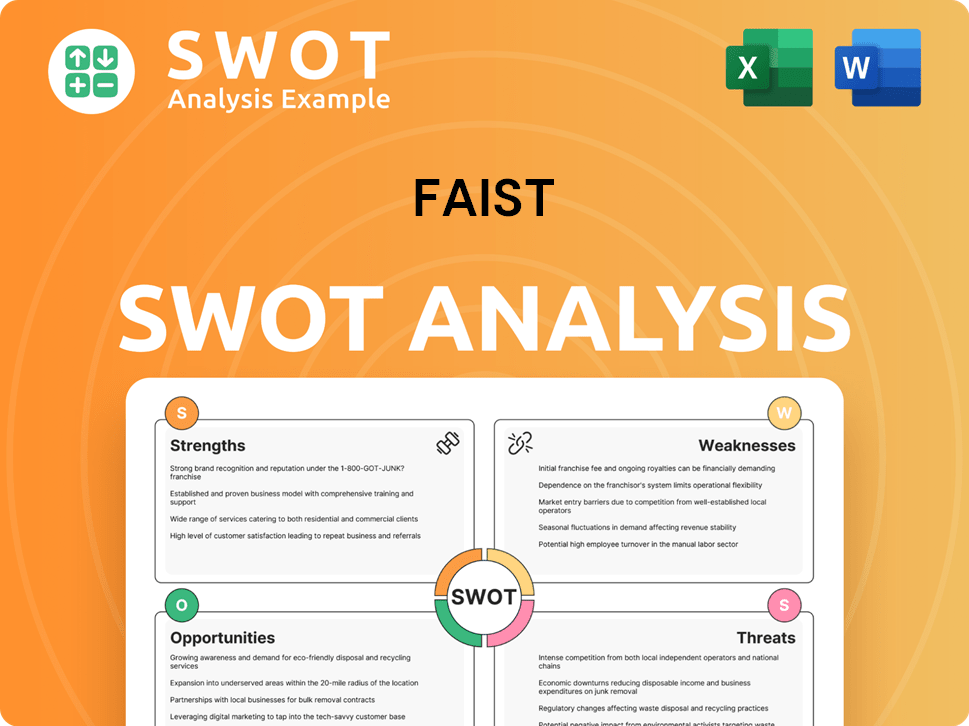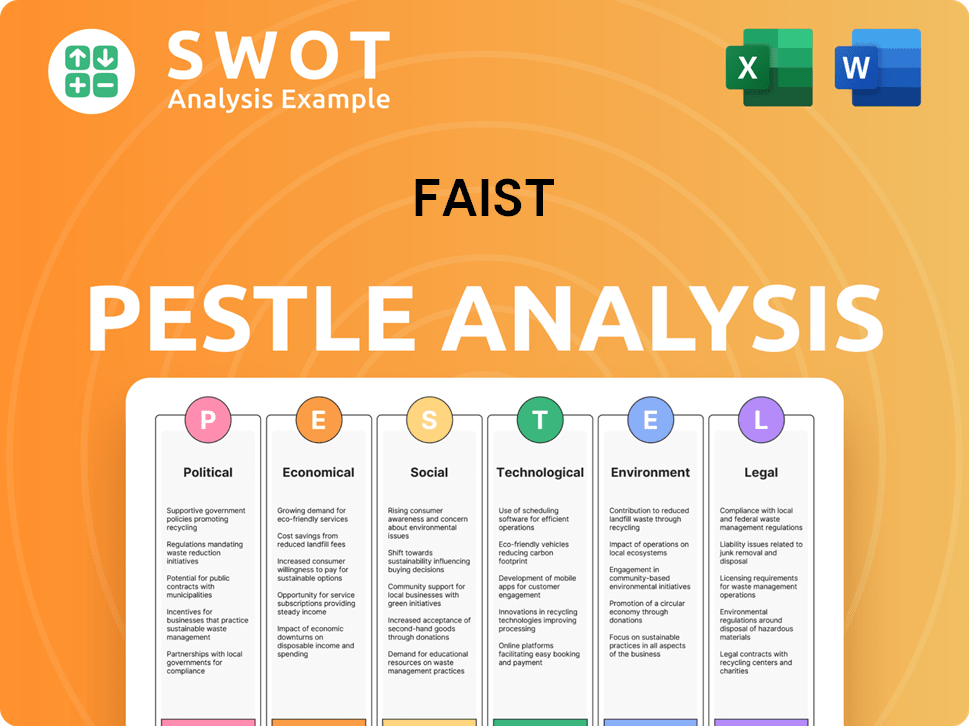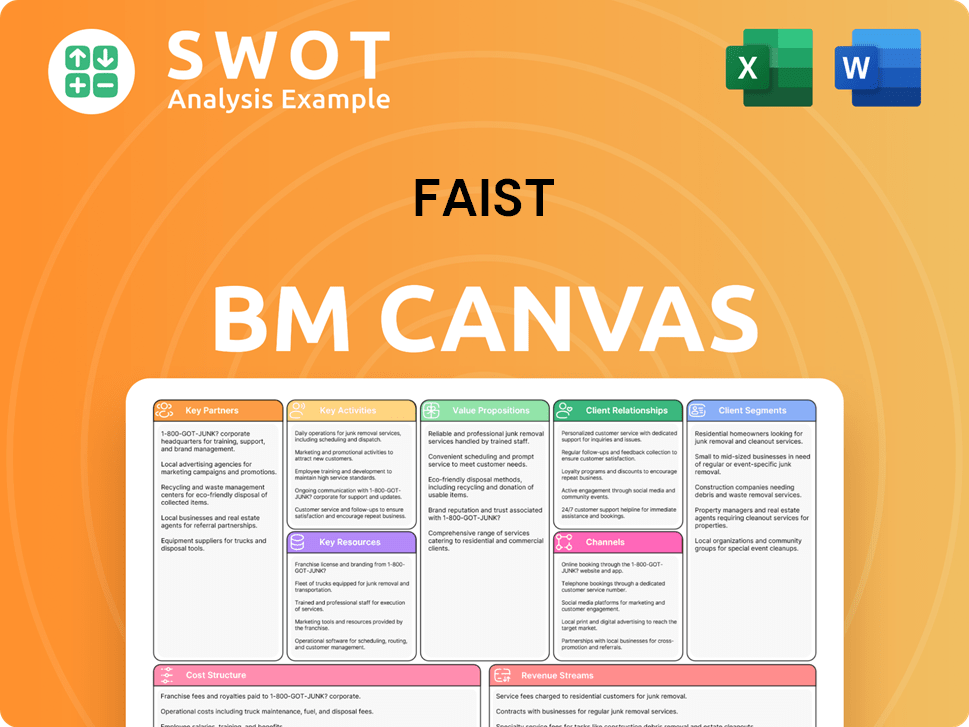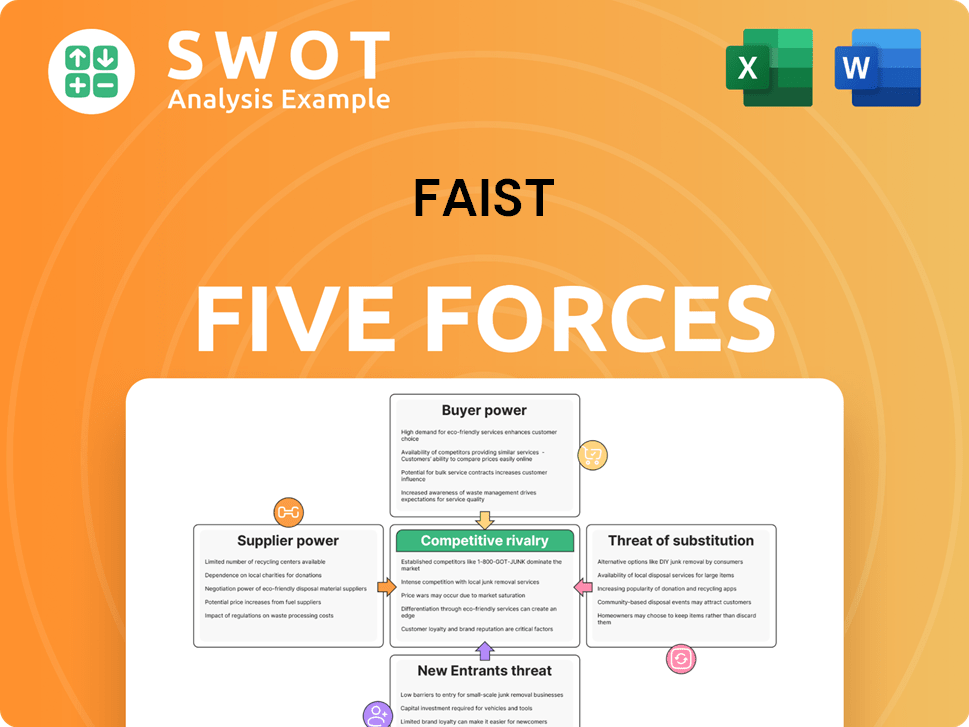FAIST Bundle
Decoding FAIST's Customer Base: Who Buys Their Industrial Solutions?
Understanding the FAIST SWOT Analysis is crucial, but it's equally vital to know who FAIST's customers are. This deep dive into FAIST's customer demographics and target market analysis reveals the core of their business strategy. From its humble beginnings to its current global presence, FAIST's evolution showcases the importance of adapting to changing customer needs.

This exploration will uncover the FAIST company's customer profiling, market segmentation, and customer acquisition strategies. We'll examine the specific needs and wants of their target market, including their geographic location and the industries they serve. Analyzing the FAIST audience will provide valuable insights into how the company has successfully navigated the complexities of the industrial solutions market, answering questions like: What are the demographics of FAIST's customers and how does FAIST define its target market?
Who Are FAIST’s Main Customers?
Understanding the customer demographics and target market analysis of the company is crucial for strategic planning. The company primarily operates in a business-to-business (B2B) model, focusing on specific industrial sectors. This targeted approach allows for specialized solutions and a deeper understanding of customer needs within these industries.
The company's target market is primarily composed of businesses across several key industrial sectors. These sectors include the automotive industry, the energy sector (specifically power plants), mechanical engineering, and the new materials industries. These companies require specialized solutions for noise control, thermal insulation, and cleanroom technology, which are the core offerings of the company.
The primary focus is on companies that need specialized solutions. This includes manufacturers of measuring and testing equipment and companies focused on noise reduction within vehicles and production facilities. The energy sector clientele includes conventional power plant operators who need noise control for turbines and air intake systems. The mechanical engineering segment involves general plant engineering and construction firms needing acoustic and insulation solutions for their industrial facilities. The new materials sector, particularly those involved in measuring, testing, and analyzing equipment, also represents a significant customer base.
The automotive industry is a significant customer segment for the company. This includes manufacturers of measuring and testing equipment and those focused on noise reduction. The global automotive market was valued at $2.8 trillion in 2024, indicating a substantial market for noise reduction solutions.
The energy sector, particularly conventional power plants, relies on the company for noise control solutions. These solutions are essential for turbines and air intake systems. The demand for these services is driven by the need to meet environmental regulations and improve operational efficiency.
General plant engineering and construction firms form another key segment. These companies require tailored acoustic and insulation solutions. This segment benefits from the company's expertise in providing customized solutions for industrial facilities.
Companies involved in measuring, testing, and analyzing equipment in the new materials sector also represent a significant customer base. This sector benefits from the company's specialized solutions for cleanroom technology and other controlled environment requirements.
The cleanroom technology market is experiencing significant growth, driven by increasing demand in pharmaceuticals, biotechnology, electronics, and medical devices. This market is projected to reach USD 8,591.5 million in 2025 and USD 15,876 million by 2035. Stricter noise regulations and the growing emphasis on controlled environments in manufacturing are also driving shifts in target segments.
- The automotive industry's reliance on noise reduction solutions remains substantial.
- The cleanroom technology market is expanding rapidly, offering significant opportunities.
- External factors, such as regulations, influence the company's target market.
- The company provides specialized solutions for noise control, thermal insulation, and cleanroom technology.
FAIST SWOT Analysis
- Complete SWOT Breakdown
- Fully Customizable
- Editable in Excel & Word
- Professional Formatting
- Investor-Ready Format

What Do FAIST’s Customers Want?
Understanding the customer needs and preferences is crucial for effective FAIST company strategy. Customer demographics for FAIST are primarily driven by the need for operational efficiency, regulatory compliance, and employee well-being. These customers require specialized solutions to mitigate noise pollution, manage thermal conditions, and ensure contamination control within their industrial facilities.
The FAIST audience prioritizes customized solutions and high-quality engineering. Their purchasing behaviors are characterized by a focus on technical expertise, a proven track record, and the ability to deliver solutions tailored to specific industrial requirements. This approach helps in effective target market analysis, ensuring that products meet the precise needs of the end-users.
The decision-making process of FAIST's clients often includes adherence to stringent occupational health and safety regulations, driving investment in high-quality noise control systems. The psychological drivers for choosing FAIST's offerings include the desire for a safer and more productive work environment. Practical drivers focus on compliance, reduced operational downtime, and enhanced product quality. For a broader understanding of the competitive environment, see Competitors Landscape of FAIST.
FAIST's customers face common pain points such as excessive industrial noise, which can lead to hearing loss and stress-related illnesses, and the need for sterile environments in sensitive manufacturing processes. Market segmentation helps in identifying specific needs within various industries. Here's a breakdown of key customer needs and preferences:
- Customized Solutions: Customers seek solutions tailored to their unique industrial requirements.
- Compliance: Adherence to stringent occupational health and safety regulations is a primary driver.
- Operational Efficiency: The need to reduce downtime and improve overall productivity.
- Quality: High-quality engineering and reliable long-term performance are essential.
- Technical Expertise: Customers value technical proficiency and a proven track record.
FAIST PESTLE Analysis
- Covers All 6 PESTLE Categories
- No Research Needed – Save Hours of Work
- Built by Experts, Trusted by Consultants
- Instant Download, Ready to Use
- 100% Editable, Fully Customizable

Where does FAIST operate?
The geographical market presence of FAIST Anlagenbau GmbH is extensive, with its headquarters located in Krumbach, Germany. The company strategically targets major markets across several continents, including Germany, China, France, Iraq, Italy, Netherlands, South Africa, Sweden, and the United States. This wide reach demonstrates a commitment to serving a global customer base and capitalizing on international opportunities.
FAIST's operational locations are strategically distributed, with facilities in Bremen and Frankenthal, Germany, as well as in Romania, the United States, and China. This distribution supports the company's manufacturing and service capabilities, allowing for localized offerings and efficient service delivery. The presence in key industrial regions like China and the United States suggests a focus on large industrial economies with significant manufacturing and energy sectors.
The company addresses differences in customer demographics, preferences, and buying power across these regions through localized offerings and partnerships. An international distributor network ensures the worldwide availability of air intake systems and enables global sourcing for competitive prices. This network supports FAIST's globally active customers, including major players like Alstom, Siemens, MAN, and Kawasaki. Analyzing the Growth Strategy of FAIST reveals how these factors contribute to the company's market success.
FAIST's approach to market segmentation involves targeting key industries and geographic regions. This includes a focus on the industrial noise control and cleanroom technology markets, which are experiencing significant growth. The company tailors its offerings to meet the specific needs of customers in different sectors and locations.
The customer demographics for FAIST include a diverse range of industrial clients across various sectors. These customers are typically businesses and organizations that require noise control solutions and cleanroom technologies. FAIST's target market analysis considers factors such as industry, location, and specific technological needs.
FAIST's customer geographic location spans across Germany, China, France, Iraq, Italy, Netherlands, South Africa, Sweden, and the United States. The company's strategic expansions and presence in key industrial regions allow it to localize its offerings and marketing. This global presence is crucial for serving a wide range of customers.
FAIST's target market industries include manufacturing, energy, and other sectors that require noise control and cleanroom technologies. The company focuses on industries where its expertise in air intake systems and related solutions is highly valued. Understanding these industries is key to FAIST's success.
The global industrial noise control market was valued at USD 5.9 million in 2023 and is projected to grow to USD 10.41 million by 2032, at a CAGR of 5.2% during 2025-2032. The cleanroom technology market is projected to reach USD 8,591.5 million in 2025 and USD 15,876 million in 2035.
- North America held the largest share in 2024 in the cleanroom technology market.
- FAIST's strategic expansions and presence in key industrial regions allow it to localize its offerings and marketing.
- The company's global presence supports its ability to serve a wide range of customers.
- FAIST's customer profile examples include major players like Alstom, Siemens, MAN, and Kawasaki.
FAIST Business Model Canvas
- Complete 9-Block Business Model Canvas
- Effortlessly Communicate Your Business Strategy
- Investor-Ready BMC Format
- 100% Editable and Customizable
- Clear and Structured Layout

How Does FAIST Win & Keep Customers?
The approach to customer acquisition and retention for FAIST Anlagenbau GmbH centers on its expertise in noise control, thermal insulation, and cleanroom technology, primarily targeting B2B clients. The company leverages its reputation and direct engagement to secure projects. Key strategies include participation in industry events, digital marketing, and a dedicated sales team. These efforts are designed to attract and retain customers in demanding industrial applications.
Customer retention at FAIST focuses on building long-term relationships through high-quality products, personalized service, and comprehensive after-sales support. The company emphasizes its role as a development partner, offering expertise throughout the project lifecycle. This approach aims to foster customer loyalty and reduce churn, recognizing that retaining customers is more cost-effective than constantly acquiring new ones.
In the B2B sector, customer retention strategies often involve building emotional connections, leveraging omnichannel support, and implementing customer feedback mechanisms. CRM systems and segmentation are critical for managing customer data and tailoring campaigns. Studies indicate that increasing customer retention by just 5% can boost profits by up to 75%, highlighting the importance of these strategies. For more insights, consider reading about Owners & Shareholders of FAIST.
FAIST uses multiple channels to acquire customers. These include industry events like the Automotive Testing Expo, the company website, and direct sales through a technical sales team. These channels help to showcase their expertise and engage directly with potential clients in their target industries. This multi-channel approach is crucial for reaching different segments of the target market.
Key marketing activities for FAIST involve showcasing its core competencies and certifications. Digital platforms, such as the company's website, are used to highlight its product and service offerings. Direct sales efforts, leveraging technical sales engineers, are vital for securing new projects, especially given the customized nature of their solutions. This targeted approach helps to reach the right customers.
FAIST focuses on long-term relationships built on trust, quality, and personalized service. The company emphasizes delivering high-quality products, offering personalized advice, ensuring fast order processing, and providing high product availability. After-sales service, including a dedicated service line, is also crucial. These strategies aim to build loyalty and encourage repeat business.
After-sales service and maintenance are critical for FAIST, with a dedicated 'FAIST SERVICE-LINE' available to address customer needs. This commitment to comprehensive support ensures customer satisfaction and builds trust. Providing excellent after-sales service is a key differentiator in the B2B market, contributing to customer retention and positive word-of-mouth referrals.
Effective B2B customer retention in 2025 includes building emotional connections, using omnichannel support, and offering loyalty programs. Implementing customer feedback mechanisms and using CRM systems are also essential. These tactics help to personalize the customer experience and build stronger relationships. The use of these strategies can significantly reduce churn rates.
- Building emotional connections through personalized interactions.
- Leveraging omnichannel support for seamless customer service.
- Offering loyalty programs to reward repeat business.
- Implementing customer feedback mechanisms for continuous improvement.
- Using CRM systems for managing customer data and tailoring campaigns.
FAIST Porter's Five Forces Analysis
- Covers All 5 Competitive Forces in Detail
- Structured for Consultants, Students, and Founders
- 100% Editable in Microsoft Word & Excel
- Instant Digital Download – Use Immediately
- Compatible with Mac & PC – Fully Unlocked

Related Blogs
- What are Mission Vision & Core Values of FAIST Company?
- What is Competitive Landscape of FAIST Company?
- What is Growth Strategy and Future Prospects of FAIST Company?
- How Does FAIST Company Work?
- What is Sales and Marketing Strategy of FAIST Company?
- What is Brief History of FAIST Company?
- Who Owns FAIST Company?
Disclaimer
All information, articles, and product details provided on this website are for general informational and educational purposes only. We do not claim any ownership over, nor do we intend to infringe upon, any trademarks, copyrights, logos, brand names, or other intellectual property mentioned or depicted on this site. Such intellectual property remains the property of its respective owners, and any references here are made solely for identification or informational purposes, without implying any affiliation, endorsement, or partnership.
We make no representations or warranties, express or implied, regarding the accuracy, completeness, or suitability of any content or products presented. Nothing on this website should be construed as legal, tax, investment, financial, medical, or other professional advice. In addition, no part of this site—including articles or product references—constitutes a solicitation, recommendation, endorsement, advertisement, or offer to buy or sell any securities, franchises, or other financial instruments, particularly in jurisdictions where such activity would be unlawful.
All content is of a general nature and may not address the specific circumstances of any individual or entity. It is not a substitute for professional advice or services. Any actions you take based on the information provided here are strictly at your own risk. You accept full responsibility for any decisions or outcomes arising from your use of this website and agree to release us from any liability in connection with your use of, or reliance upon, the content or products found herein.